Calf Rearing
Most extensive beef suckler cow systems tend to involve allowing calves to stay with their dam throughout the natural sucking period. However, most dairy systems involve removal of calves soon after birth. For many this is the most practical approach to efficient milk production but it raises welfare issues.
Once separated from the dam, there are key practices that should apply to achieve the highest standards of welfare:
• Calves should be housed in groups and be free to move unhindered (not tethered) to enable them to seek social contact and develop social skills;
• Housing should be of sufficient space and contain clean comfortable bedding;
• Calves should be fed on whole milk.
There are opportunities to enhance the welfare of calves separated from their mothers by providing a nurse cow for them to satisfy their natural motivation to suck, or by developing innovative systems of allowing calves to stay with their own dam for at least some of the day and for parts of the lactation.
What happens at calving?
The care that a mother provides to its offspring soon after birth not only impacts on survival but also influences the physiological and psychological development of the young in the short, medium and long term (Poindron, 2005). Our management systems should attempt to provide conditions that enable new mothers to behave in a natural manner that enable them to effectively care for their young.
There appear to be large individual differences in the way cows behave during calving (Lidfors et al., 1994) although generally cows become restless a few days before calving and tend to separate themselves from the rest of the herd a few hours before calving and prepare a ‘nesting’ site. They do not appear to spend a great deal of time and effort preparing the site and remain there for only a short period after calving. However, it appears that they prefer dry sites and especially those with tree cover and overhead branches, or under shelter (Lidfors et al., 1994).
The majority of cows lie-down to calve but stand soon after calving to allow the calf to suckle (von Keyserlingk and Weary, 2007). It appears that under natural conditions, cows will attempt to hide their calf during the first days after birth.
Within minutes of birth and for several hours afterwards, cows spend much of the time licking their newborn calf (Lidfors and Jensen, 1988; Illmann and Špinka, 1993) and this is felt to be important in stimulating calf activity, breathing, circulation, urinating and defecating as well as drying the coat to prevent heat loss. Some mothers, and particularly first calving heifers, fail to lick their calves within the first 6 hours and this can cause a breakdown of the maternal bond and rejection of the calf (Edwards, 1983; Le Neindre and D’Hour., 1989). It has also been suggested that cross-licking, whereby cows lick other newly born calves, may be a risk factor for calf rejection (von Keyserlingk and Weary, 2007) as it potentially interferes with the cow-calf bonding process (Edwards, 1983). The risk may be enhanced when cows are block and group calved.
Are they getting enough? Ensuring sufficient colostrum
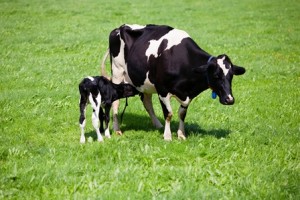 All new born calves should receive adequate colostrum, preferably from their own dam, within six hours of birth as they rely entirely on this as a source of antibodies as well as vitamin A and D. After this time, levels of antibodies in the dam’s milk starts to decline and after 24 hours antibodies are no longer absorbed into the calves bloodstream. Colostrum will protect the calf against the diseases that the mother has been exposed to, so for heifers calving for the first time, it may be useful to expose them to older cows in the month before calving so as to increase exposure (Ohnstad, 2015).
All new born calves should receive adequate colostrum, preferably from their own dam, within six hours of birth as they rely entirely on this as a source of antibodies as well as vitamin A and D. After this time, levels of antibodies in the dam’s milk starts to decline and after 24 hours antibodies are no longer absorbed into the calves bloodstream. Colostrum will protect the calf against the diseases that the mother has been exposed to, so for heifers calving for the first time, it may be useful to expose them to older cows in the month before calving so as to increase exposure (Ohnstad, 2015).
For more information on colostrum and in particular controlling early calf diarrhea click HERE.
After giving birth, most cows tend to consume the placenta and amniotic fluid they have produced (placentophagia), and there is a possibility that they do this to protect their young from predators by removing the evidence of birth, but also because it is thought to have pain relieving (analgesic) and other qualities (von Keyserlingk and Weary, 2007). Cows respond to the calves need to suck within hours of birth, and the response to the stimulus to suckle can vary between beef and dairy cattle – beef animals tending to start mothering sooner after calving than dairy cows (Selman et al., 1970; Edwards and Broom, 1979).
Group housing of calves
Calves reared in groups are more social, confident and show less fear than calves reared in single boxes or in isolation (Jensen et al., 1997; Bøe and Færevik, 2003). Early learning and increase in solid feed consumption, greater access to space and better social interaction elicit better welfare in group housed calves (Babu et al., 2004). Housing dairy calves in pairs rather than individually allows benefits such as increased space for movement and social opportunities with no disadvantages in health and weight gains. Paired rather than individual housing during the milk-feeding stage also reduces calf responses to weaning and improves performance after weaning if calves are then housed in groups (De Paula Vieira et al., 2010).
More social
Calves raised with full social contact (either from birth or from 3 weeks of age) establish a stronger bond with their companion than do calves housed with limited contact (Duve and Jensen, 2011). Individually housed calves spend less time suckling, feeding, exploring and moving (Seo et al., 1998). Calves seem to prefer a familiar calf to an unfamiliar calf, and the presence and familiarity of a companion calf affects the reaction to separation (Færevik et al., 2006).
Faster growing
Group rearing may facilitate the start of eating and ruminating earlier than individual housing (Hepola et a., 2006), resulting in calves gaining weight faster post-weaning than isolated calves. Group reared calves also tend to rank highest in the social hierarchy in post-weaning groups that include individually reared animals (Warnick et al, 1997).
Healthier
Housing calves in groups of under 10 calves has been shown to be preferable from a health and growth perspective, with lower levels of respiratory disease than that found in larger groups (Svensson and Liberg, 2006). Housing in small-group pens can result in lower mortality compared with single pens and large-group pens with automatic milk feeders (Svensson et al., 2006). Calves in larger groups are generally more active, displace other calves less frequently from the feed barrier and show increased proximity to other calves (Færevik et al., 2007).
Natural Rearing
While nipple-type artificial milk feeders are preferable to feeding calves by bucket, they are not able to satisfy sucking motivation completely and it has been shown that permanent and even restricted contact with the mother brings behavioural advantages (Lidfors et al., 2002).
The introduction of single suckling systems in dairy calf rearing has the potential to further enhance animal welfare in terms of ‘natural living’. The systems described by Wagenaar and Langhout, (2007) involved cows calving in separate calving pens and remaining with their calf for the first 48–72 hours before being returned to the milking herd along with the calf. Cows were machine milked twice per day and the calves remained with their mother for the first three months of life. The single suckled calved reached higher weaning weights at 3 months of age, supporting the conclusions of Jasper and Weary (2002) that ad libitum nipple feeding of milk to dairy calves results in increased milk intake and weight gain with no detrimental effects on intake of solid food after weaning . There were no immediate animal health problems linked to suckling systems and compared with traditional bucket feeding of milk, suckling systems resulted in increased natural behaviour such as calf–cow bonding, natural sucking behaviour and care-taking behaviour. Grøndahl et al (2007) came to a similar conclusion when observing calves penned together with cows for 6–8 weeks of age.
Artificial rearing: how much to feed?
Dairy calves are typically fed only about half of their ad libitum milk intake and are highly motivated to drink more milk. Observing the behaviour of calves at feeding can help to identify whether sufficient milk is being provided as they tend to be more active when there is sufficient (De Paula Vieira et al., 2008).
There are issues with stress at weaning and loss of marketable milk but the researchers concluded that in order to implement a successful single suckling dairy system, farmers have to step back from control and give the calf and cow a chance and also that farmers should be encouraged to take enough time to undergo and attitude change (Wagenaar and Langhout, 2007). The issue of stress at cow-calf separation is contentious, and there is research to show that whilst calves separated at 2 weeks rather than 1 day of age gain more weight and are more social, the response of cows and calves to separation is more intense and lasts longer when separation is delayed and that this effect lasts longer and is greater if the pair are within vision and ear-shot after separation (Flower and Weary, 2001). Conversely, delayed separation can have a positive influence on a calf’s coping abilities post-separation, with greater exploratory activity by the calf (Stěhulová et al., 2008).
An alternative to single suckling is the rearing of a number of calves on a single foster or ‘nurse’ cow. This approach promotes natural sucking as a means of enabling calves to satisfy their strong motivation to suck, to form strong bonds with their mother and seek out social contact with other calves. Work conducted in Holland, Rearing calves with cows:nature works! (Wagenaar and Langhout, 2007) describes a natural dairy rearing systems. An innovative system that would fit with a commercial dairy farm would be to allow calves to remain with their mother for a period of up to one week before transferring calves to a nurse or foster cow.
Cross-sucking
Typically, when calves are removed from their mothers very soon after birth and placed with other calves, they are occasionally motivated to suck others. This activity is not related to hunger and since calves are motivated to cross-suck others more after feeding than before, Lund and Weary in Vaarst et al (2005) recommend that efforts to reduce this should focus around feeding times and should be started early in life (Lidfors and Isberg, 2003). The use of nipple feeders reduces cross-sucking by allowing calves to express this natural sucking behaviour while feeding. The problem can be further alleviated by providing sufficient nipples for all calves to feed separately and/or providing enclosed feeding stations that allow uninterrupted feeding.
Restricted suckling systems provide an option that have been shown to reduce cross-sucking, the licking objects and other behavioural impacts compared with artificially reared calves (Fröberg et al., 2008; Hernández et al., 2006). These systems can also improve the udder health of dams.
Fostering and multiple suckling
An alternative and perhaps more natural approach to artificial rearing of calves removed from the dam early in life is to use nurse cow rearing. This involves one or more calf being fostered by a nurse cow.
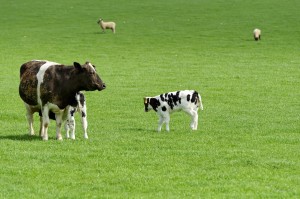 Fostering can be a stressful time of cow and foster calves. The success of introducing a calf to a nurse cow is expected to depend on the calf’s suckling experience, as well as the introduction procedure. Calves that suckle colostrum from their own mother have been shown to suckle a nurse cow more and for longer periods than those fed colostrum from a teat-bucket. The fostered calves also tended to lick and rub their nurse more and these calves cross-suckled less than teat-bucket fed calves (Vaarst et al., 2001).
Fostering can be a stressful time of cow and foster calves. The success of introducing a calf to a nurse cow is expected to depend on the calf’s suckling experience, as well as the introduction procedure. Calves that suckle colostrum from their own mother have been shown to suckle a nurse cow more and for longer periods than those fed colostrum from a teat-bucket. The fostered calves also tended to lick and rub their nurse more and these calves cross-suckled less than teat-bucket fed calves (Vaarst et al., 2001).
A successful method of fostering calves onto nurse cows is described by Hudson (2007) involving the cow’s own calf being removed at birth and before she had any contact with it. Pre-selected calves, wiped with the amniotic fluid, were introduced to the cow within 2 min of birth resulting in the forming of a rapid maternal bond between the cow and all the foster calves. There was no cross suckling and uniform growth rates were achieved.
Odour transfer via cloth jackets/stockinettes appears to be an inexpensive, rapid and safe technique to facilitate the maternal acceptance of alien calves by postpartum beef cows (Dunn et al., 1997).
Loberg and Lidfors (2001) concluded that both Swedish Holstein and Red and White dairy breeds and from different stages of lactation accept alien foster calves equally well.
When and how to wean?
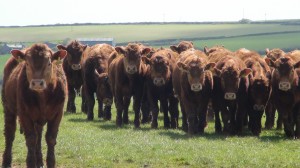
Weaning of calves involving either removal from the mother before they would naturally do so, or the cessation of artificial milk feeding, can present significant welfare issues. It can also be a critical time with regard to productivity, as calves often suffer a severe check to growth when they are first weaned from milk.
Let’s consider the situation where a calf has been allowed for a significant period of time, such is the case with many beef breeding herds. The most effective approach with the least welfare implications would be allow the calf to remain with, or at least within touching distance, of the mother. A physical barrier can be used to separate cow from calf, allowing physical contact but not sucking. For example, a fence line contact between beef calves and cows for 7 days following weaning reduces the behavioural distress seen in the totally separated calves. It can also result in minimising the weight loss frequently seen following weaning (Price et al., 2003).
The use of a non-injurious barrier such as plastic nose-flap can be used to prevent a calf from sucking whilst remaining with its mother. This strategy can be used successfully in a two stage weaning process. The second phase involves physical separation after approximately a week and the evidence suggests that the negative behavioural responses seen following a single stage removal are greatly reduced (Haley et al 2005).


 American English
American English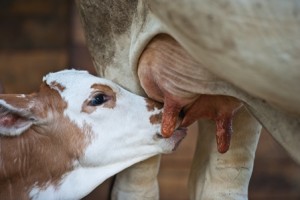
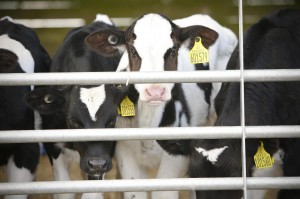
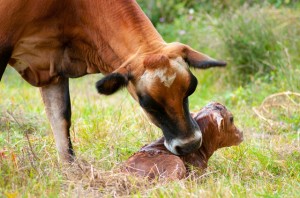
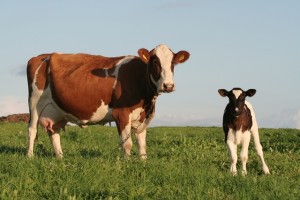
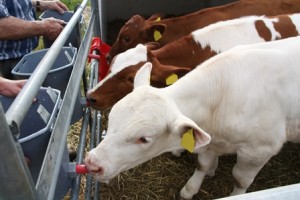
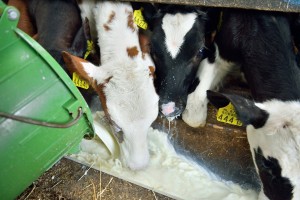


Comments are closed.